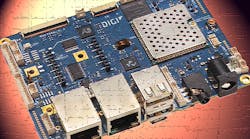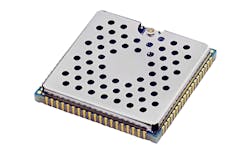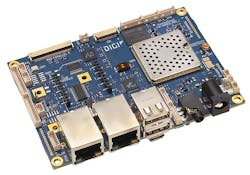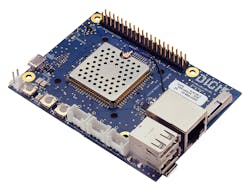Designing a new product is a long, difficult task requiring many critical decisions. To be consistently successful, engineers must carefully consider many competing variables, including processing power, security, I/O functions, time to market, cost of the final design, transfer to manufacturing, certifications, future proofing, etc.—the list goes on and on.
One critical decision, when made correctly, will help meet many of these critical variables: the computing platform itself. Should it be a system on module (SOM), a single-board computer (SBC), or should a ground-up design be initiated—chip down? This decision, perhaps more so than any other at the initial phase of new product development, is essential when it comes to factors that contribute to success of the product development.
Design engineers must consider the many costs and tradeoffs during this journey. Each choice will directly affect the success of the product. Their performance in design execution will directly affect the company’s bottom line by affecting time to market, engineering costs, and quality of the design. For purposes of this specific discussion, it’s necessary to momentarily set aside market research, market need and product viability.
It’s a SOM!
By way of illustration, we will follow a typical journey that design engineers take through this process. But before we do that, we should stop and ask: Why do SOMs exist?
Ever since embedded-application processors evolved to achieve performance levels of desktop computers, cell phones, and tablets, their sheer complexity and design nuances have often resulted in over-extended, costly development programs. Engineers found themselves making the same complex computing circuit with the same software platform over and over for many new products they were designing: processor, memory, power management (PMIC), Wi-Fi, and security.
So, why not reuse the design they spent the last eight months working on and use it again on the next design? Great idea! Thus, the system on module, or SOM, was born. Conceptually, the SOM parallels the integrated circuit, where many circuits are combined into a single chip. Arguably, it could be said that almost everything on a SOM today will land in an IC tomorrow.
Shorter Time To Market
SOMs on the market today have been optimized for space, functionality, and ease of use. SOMs are proven and ready to go with no debugging of hardware or software, including the board support package. The core computing platform is complete: software drivers, schematic design, layout (including time-consuming placement and difficult DDR routing), board support package, security, and wireless connectivity. SOMs also have complete alpha prototypes, beta prototypes, pre-production runs, and certifications. By using a SOM for the computing platform, design engineers can focus their efforts and resources on the application rather than getting mired in the details of designing a computing platform.
Digi’s ConnectCore 6UL module offers a secure and cost-effective connected system-on-module platform that’s slightly bigger than a postage stamp.
SOMs also have a complete manufacturing test system designed, built, tested, and proven for that SOM. To put the value of this into perspective, consider that for complicated core processing circuits, the cost of a manufacturing test system alone could blow the NRE budget and project timeline.
For those charged with developing a new product, the question is NOT “will I save time?” They know that using a SOM will shorten the time to market.
Turn Up the Volume
When the new product requires performance that has been implemented on a SOM, a SOM is a great choice. High-volume products must get to market ASAP. Engineers need to focus all of their resources on the application-specific components and make use of the integrated software on the SOM. Getting the product to market quickly will save engineering and test costs while bringing in revenue months sooner. As the engineer continues to dial in the user experience, ironing out the design glitches and manufacturing bugs, the product is being manufactured, sold, and most importantly, earning revenue sooner than an alternate “chip down” effort.
Low-volume products also need to get to market ASAP. The engineering cost for the product development and manufacturing test will take much longer to amortize due to the lower volumes. In this situation, it’s best to use as many “off-the-shelf” components as possible to keep non-recurring engineering (NRE) down.
Chip Down
Those desiring to build the entire circuit and proceed with a “chip down” design must consider their engineering team’s capabilities: Do they have the technical experience to execute quickly without multiple board re-spins? Do they have expertise needed in the low-level kernel software? Do they understand security? Is the team large enough to take on this product development along with all of the other engineering work? After this consideration, some engineers wisely decide they will not re-invent the wheel. They realize that a SOM is simply a big IC and they should take advantage of all integration that has been completed.
In the future, when asked to reduce the cost of his successful product, an engineer can use the revenue from the product sales to outsource a chip down solution. Now the product is well-defined, performance is understood, and market acceptance is known. The engineer can choose to use internal resources or outsource this well-defined task. This process could be initiated a few months to a few years after product launch. Outsourcing requires little time and allows the engineer to focus energy on the next product development effort, which is being funded by the first product’s revenue.
Single-Board Computers
Shown is the ConnectCore 6UL SBC Pro, a secure, pre-certified connected single-board computer in standard form factor with complete design flexibility.
In a different scenario, the product design requires an ultra-fast development time and several standard peripherals with leniency on the form factor for the final product. A single-board computer (SBC) is a great choice here. SBCs are ready to go and include all of the standard peripherals and wireless connectivity options. Just like the SOM, the entire development and manufacturing test is complete and all the design engineer needs is a box and an application. If the application takes one month, then the time to market is one month.
SBCs continue to evolve in sophistication, and the range of possibilities continues to expand. As those capabilities grow, so do the choices for smart design engineers. Greg Starns, executive director of the software development group at Frazer-Nash, an innovative electric car company, summed up the advantages of using SBCs this way: “The Digi ConnectCore 6 has given us all the capabilities we had hoped for while cutting our development time 15-fold. Its intelligence and usability fell perfectly in line with what we expect from our own development.”
The ConnectCore 6UL SBC Express is a secure and pre-certified connected SBC that helps speed up and simplify design integration in industrial applications.
Ultimately, deciding which computing platform to use when designing a new product depends on a careful analysis of the advantages of each option as well as the product being designed. Each platform has its advantages and disadvantages. However, design scalability/reuse, ease of use, time-to-market constraints, and existing in-house technical expertise are the factors that can help guide the decision on whether to use a SBC, a SOM, or chip down design.




